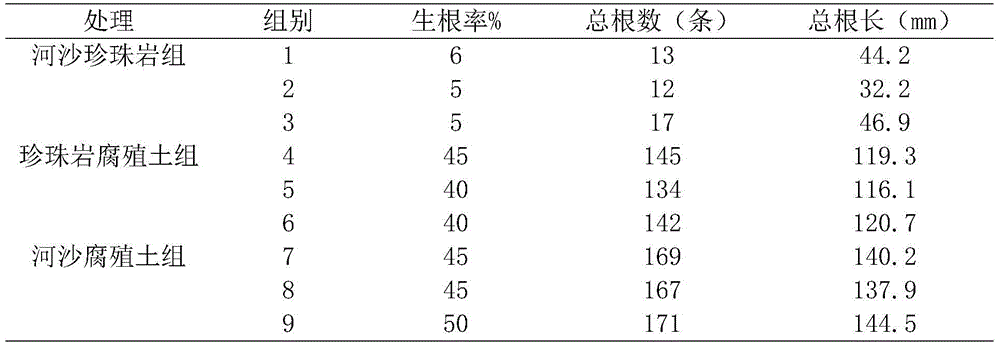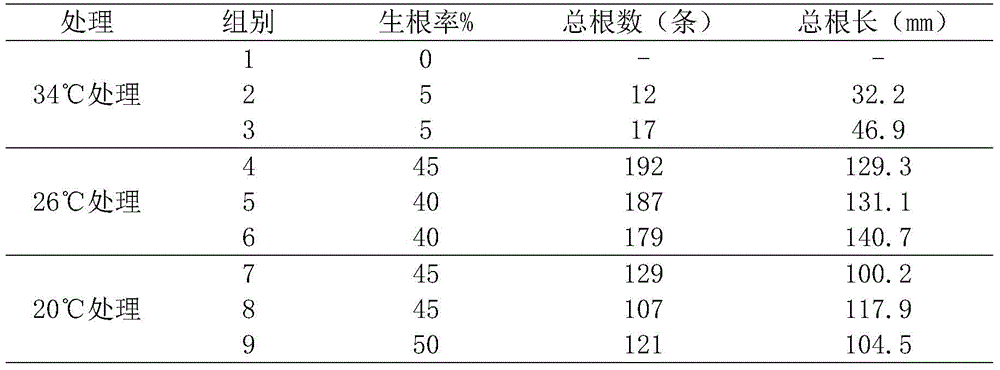Asexual Propagation Method of Artemisia annua Based on Maintaining the Species of Female Parents of Fine Varieties
A technique of asexual reproduction and Artemisia annua, applied in botany equipment and methods, horticulture, application, etc., can solve the problems of difficult operation and achieve the effects of less difficult management, maintenance of species, and high rooting survival rate
- Summary
- Abstract
- Description
- Claims
- Application Information
AI Technical Summary
Problems solved by technology
Method used
Image
Examples
Embodiment 1
[0021] Example 1 Investigation of the Effects of Different Cutting Substrate Conditions on Rooting of Artemisia annua Cuttings
[0022] Collect Artemisia annua plants with an artemisinin content higher than 0.9% in Youyang, Chongqing, and collect cuttings in July-August of that year. Cuttings use side branches (randomly selected) from the upper, middle and base of the plant, 3 nodes / branch, and remove the base 2 Nodal leaves, leaving half of the upper node, inserted obliquely into the substrate, and 2 nodes into the soil; 20 branches / treatment.
[0023] In this experiment, the mixture of river sand and humus was used as the substrate instead of soil or perlite, because it was found in the previous pre-experiment that the base of the cuttings was easy to rot when soil was used as the substrate, while the perlite The water retention effect is not as good as river sand, which has good water permeability and air permeability. However, river sand as a substrate is easy to dry, so ...
Embodiment 2
[0027] Example 2 Investigation of the Effects of Different Cutting Temperature Conditions on Rooting of Artemisia annua Cuttings
[0028] Collect Artemisia annua plants with an artemisinin content higher than 0.9% in Youyang, Chongqing, and collect cuttings in July-August of that year. Cuttings use side branches (randomly selected) from the upper, middle and base of the plant, 3 nodes / branch, and remove the base 2 Nodal leaves, leaving half of the upper node, inserted obliquely into the substrate, and 2 nodes into the soil; 20 branches / treatment. In order to realize the temperature control of the large environment, the experimental plots were selected in the Youyang area at an altitude of 430m (the ambient temperature in July and August is 30-37°C, and the average temperature is 34°C), and an altitude of 890m (the ambient temperature in July and August is 24- 28°C, the average temperature is 26°C), and the altitude is 1320m (the ambient temperature in July and August is 15-23°...
Embodiment 3
[0054] Example 3 Effects of Different Cutting Seasons on the Survival Rate of Cuttings
[0055] Collect Artemisia annua plants with an artemisinin content higher than 0.9% in the Youyang area of Chongqing, collect cuttings in May-June of that year, use side branches (randomly selected) from the upper, middle and base of the plant for cuttings, and make cuttings as treatment A; Gather cuttings in July-August, and cuttings use the side branches (selected at random) of the top, middle and base of the plant to make cuttings as processing B; gather cuttings in September-October that year, use the side branches (selected at random) of the top, middle and base of the plant for cuttings. ), making cuttings as processing C. Leave 3 nodes for each cutting, remove 2 leaves at the base, leave half a leaf at the upper node, insert obliquely into the substrate, and 2 nodes into the soil. For each treatment, 3 groups were paralleled, with 20 branches in each group; the ambient temperature...
PUM
 Login to View More
Login to View More Abstract
Description
Claims
Application Information
 Login to View More
Login to View More - Generate Ideas
- Intellectual Property
- Life Sciences
- Materials
- Tech Scout
- Unparalleled Data Quality
- Higher Quality Content
- 60% Fewer Hallucinations
Browse by: Latest US Patents, China's latest patents, Technical Efficacy Thesaurus, Application Domain, Technology Topic, Popular Technical Reports.
© 2025 PatSnap. All rights reserved.Legal|Privacy policy|Modern Slavery Act Transparency Statement|Sitemap|About US| Contact US: help@patsnap.com



